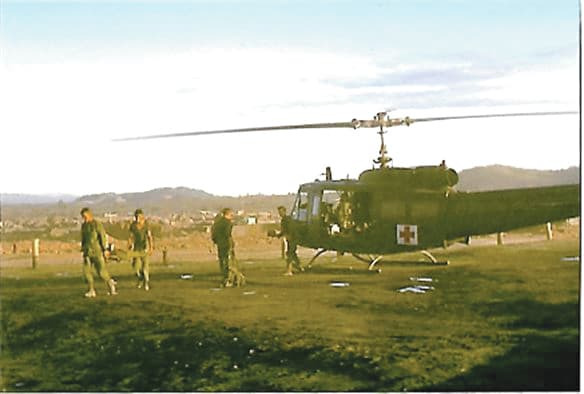
WRIGHT-PATTERSON AIR FORCE BASE — Original members of the 903rd Aeromedical Evacuation Flight will gather at Wright-Patterson Air Force Base May 20 to celebrate its 50th anniversary.
Established in February 1967, the 903rd Aeromedical Evacuation Flight was the first Air Force tactical aeromedical unit used in a combat area.
Initially operating out of the 21st Aeromedical Evacuation Squadron at Pope Air Force Base, Nc., and the 22nd Aeromedical Evacuation Squadron at Seward Air Force Base, Tenn., personnel and equipment from the two squadrons were combined to deploy to Phu Cat Air Base, Republic of Vietnam, in March 1967.
The 903rd Aeromedical Evacuation Flight’s role was to assist the Army and Marines by administering medical care and evacuating casualties to in-country surgical hospitals and naval hospital ships; C-130s, C-7As, C-123s and various helicopters were utilized for the evacuations.
This first-of-its kind unit was comprised of a 12-person emergency medical care team that included a medical service corps officer, a non-commissioned officer in charge, eight aeromedical evacuation technicians, a radio operator and an administrative specialist.
“A battle casualty would be airlifted from the point of injury by helicopter and brought to a forward combat medical facility for emergency treatment of battle injuries. The more serious injured patients would be stabilized and brought to us for evacuation by fixed wing aircraft,” said original team member and reunion organizer retired Chief Master Sgt. Charles Fox.
Fox served on the team as an aeromedical evacuation technician and is also the father of Col. Shari Silverman, commander of the 88th Medical Group.
“It is important to note that this schedule of operations could change anytime based on the numbers and conditions of patients,” said Fox. “At Khe Sanh, during the 1968 Tet Offensive, some casualties were brought directly from the field to our Casualty Staging Facilities for evacuation.”
Staged at various combat bases with airstrips located in Vietnam where heavy casualties were anticipated, these teams mobilized and operated out of self-contained medical care units called Casualty Staging Facilities.
The unit provided care for combat casualties awaiting airlift and in-flight care during the evacuation flight. However, the technicians were limited to the type of care they could provide.
“Sadly, very minimum equipment (an Ambu bag for resuscitation, Ambu foot suction) and assorted medical bandages and supplies were provided,” said Fox.
Since the Casualty Staging Facility’s inception, medical advances have vastly improved allowing staging facilities to provide much more medical care to the injured. Today, Casualty Staging Facilities are now called En-Route Patient Staging System (ERPSS).
In today’s aeromedical staging facilities like the one located here at the 445th Airlift Wing, the same medical care and procedures in emergency rooms can be provided to the injured. Specialized equipment, surgical and intensive care units are all now included in the ERPSS.
During the conflict, the 903rd Aeromedical Evacuation Flight was responsible for assisting with initial and providing in-flight medical care to thousands of wounded service member and for their efforts in supporting the mission, the unit was awarded the Air Force Presidential Citation, the Marine Corp Presidential Citation, and the Air Force Outstanding Unit Citation.
Fox along with retired Lt. Col. Jim Fincher, retired Maj. Jay McCausland, retired Senior Master Sgt. Ken Harris, retired Tech. Sgt. Vic Salyer, and Airmen Virgil Downing, Larry DuPree, Dan Hendrix, and Rob Pearce, who will all be attending the reunion, were some of the original team members.
As part of the schedule of events during the reunion, on May 20, the alumni will visit the United States Air Force Medical School of Aerospace Medicine where they will be shown the advancements in aeromedical evacuation.
Senior Master Sgt. Lisa Harelson, Superintendent of the Aeromedical Evacuation Formal Training Unit, Detachment 4, 375th Operations Group, said she is honored to have the opportunity to meet her aeromedical evacuation brothers and sisters from the Vietnam era.
“Not all nurses and medics experience caring for combat wounded straight from the battlefield; this is a bond we share,” said Harelson. “The medical professionals in aeromedical evacuation are continuously striving to provide better, faster care for our wounded and this would not be possible without the consultation provided by the 903rd Aeromedical Evacuation Flight. We would not be where we are today without them.


